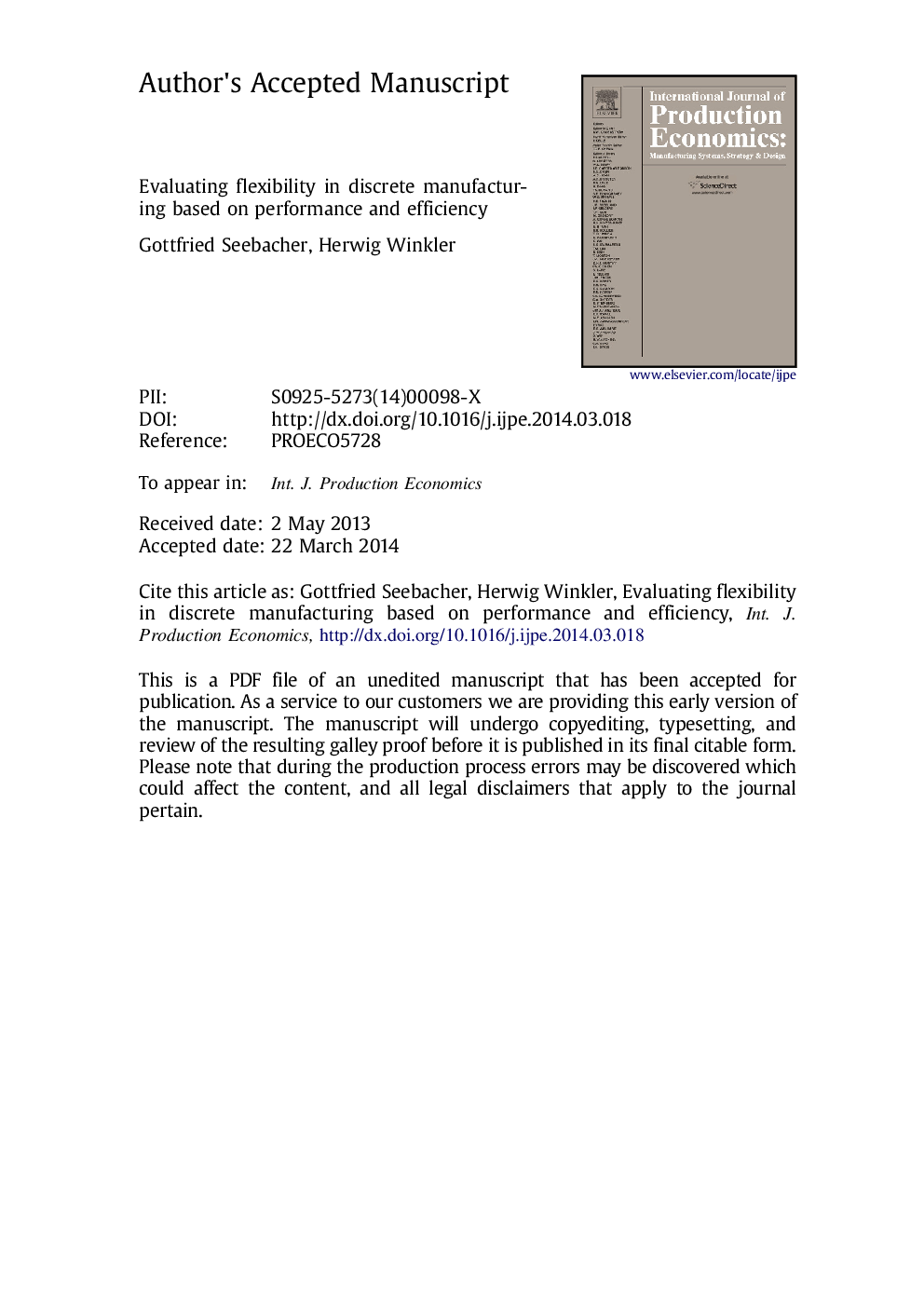| کد مقاله | کد نشریه | سال انتشار | مقاله انگلیسی | نسخه تمام متن |
|---|---|---|---|---|
| 5080110 | 1477559 | 2014 | 37 صفحه PDF | دانلود رایگان |
عنوان انگلیسی مقاله ISI
Evaluating flexibility in discrete manufacturing based on performance and efficiency
ترجمه فارسی عنوان
ارزیابی انعطاف پذیری در تولید گسسته بر اساس عملکرد و کارایی
دانلود مقاله + سفارش ترجمه
دانلود مقاله ISI انگلیسی
رایگان برای ایرانیان
کلمات کلیدی
انعطاف پذیری تولید اندازه گیری، بهره وری تولید، درجه انعطاف پذیری،
ترجمه چکیده
تحولات اقتصادی اخیر نشان داد که انعطاف پذیری بیشتر در تولید از همیشه مهمتر است و ما انعطاف پذیری را به عنوان یک هدف کلیدی در بسیاری از سیستم های تولیدی می دانیم. توانایی ارائه معینی از انعطاف پذیری سیستم های تولید باید در تولید آینده تعیین شود. هدف از این مقاله ارائه یک رویکرد کاربردی برای ارزیابی انعطاف پذیری در تولید گسسته است. بنابراین، ما یک مدل دو بعدی برای رسیدن به عملکرد و کارایی سیستم های تولید دسته ای تولید کردیم. در نتیجه، برای ارزیابی انعطاف پذیری تولید، ضریب تغییرات از انحراف زمان تولید زمان سفارش تولید را محاسبه می کنیم. علاوه بر این، ما یک ضریب کارایی را محاسبه می کنیم که نشان می دهد که آیا انعطاف پذیری بیشتر از عملکرد تولید یا از دست دادن تولید مانند سطوح موجودی بیش از حد و یا ظرفیت های بیش از حد افزایش می یابد. مدل انعطاف پذیری فعلی نشان می دهد که چگونه درجه انعطاف پذیری تولید را تعیین می کند و چگونه شرایط انعطاف پذیری متفاوت و هر گونه پیشرفت در انعطاف پذیری را نشان می دهد. رویکرد ارزیابی ما بر اساس داده های قابل دسترس در دسترس است و برای هر سیستم تولید سری با فرآیندهای تولید گسسته قابل استفاده است. در نهایت، ما دستورالعمل مشخصی برای تمرینکنندگان ارائه می دهیم که روش ارزیابی و مراحل محاسباتی را برای ارزیابی انعطاف پذیری تولید ارزیابی می کند. امکان سنجی عملی و کاربرد رویکرد فعلی با یک مثال نشان داده شده است که نشان می دهد دقیقا چگونگی ارزیابی انعطاف پذیری تولید و چگونگی اندازه گیری بهبود انعطاف پذیری در عمل کاری را نشان می دهد.
موضوعات مرتبط
مهندسی و علوم پایه
سایر رشته های مهندسی
مهندسی صنعتی و تولید
چکیده انگلیسی
Recent economic developments indicated that greater flexibility in manufacturing is more important than ever and we consider flexibility as a key objective of many manufacturing systems. The ability to provide a certain degree of flexibility of production systems must be prioritized in future manufacturing. The purpose of this paper is to present an applicable approach for the evaluation of flexibility in discrete manufacturing. Therefore, we developed a two-dimensional model to capture the performance and the efficiency of batch production systems. As a result, to evaluate manufacturing flexibility, we calculate a coefficient of variation from the deviations of the production order lead times. In addition, we compute an efficiency coefficient that indicates whether increased flexibility results from the manufacturing performance or from production waste, such as excessive inventory levels and/or excess capacities. The current flexibility model shows how to determine the degree of manufacturing flexibility and how to illustrate different flexibility situations and any improvements in flexibility. Our evaluation approach is based on readily available data and it is applicable to any batch production system with discrete manufacturing processes. Finally, we provide a clearly arranged guideline for practitioners clarifying the evaluation procedure and the computational steps to evaluate the manufacturing flexibility. The practical feasibility and the application of the current approach are demonstrated by an example that shows exactly how to evaluate the manufacturing flexibility and how to measure an improvement of flexibility in business practice.
ناشر
Database: Elsevier - ScienceDirect (ساینس دایرکت)
Journal: International Journal of Production Economics - Volume 153, July 2014, Pages 340-351
Journal: International Journal of Production Economics - Volume 153, July 2014, Pages 340-351
نویسندگان
Gottfried Seebacher, Herwig Winkler,
